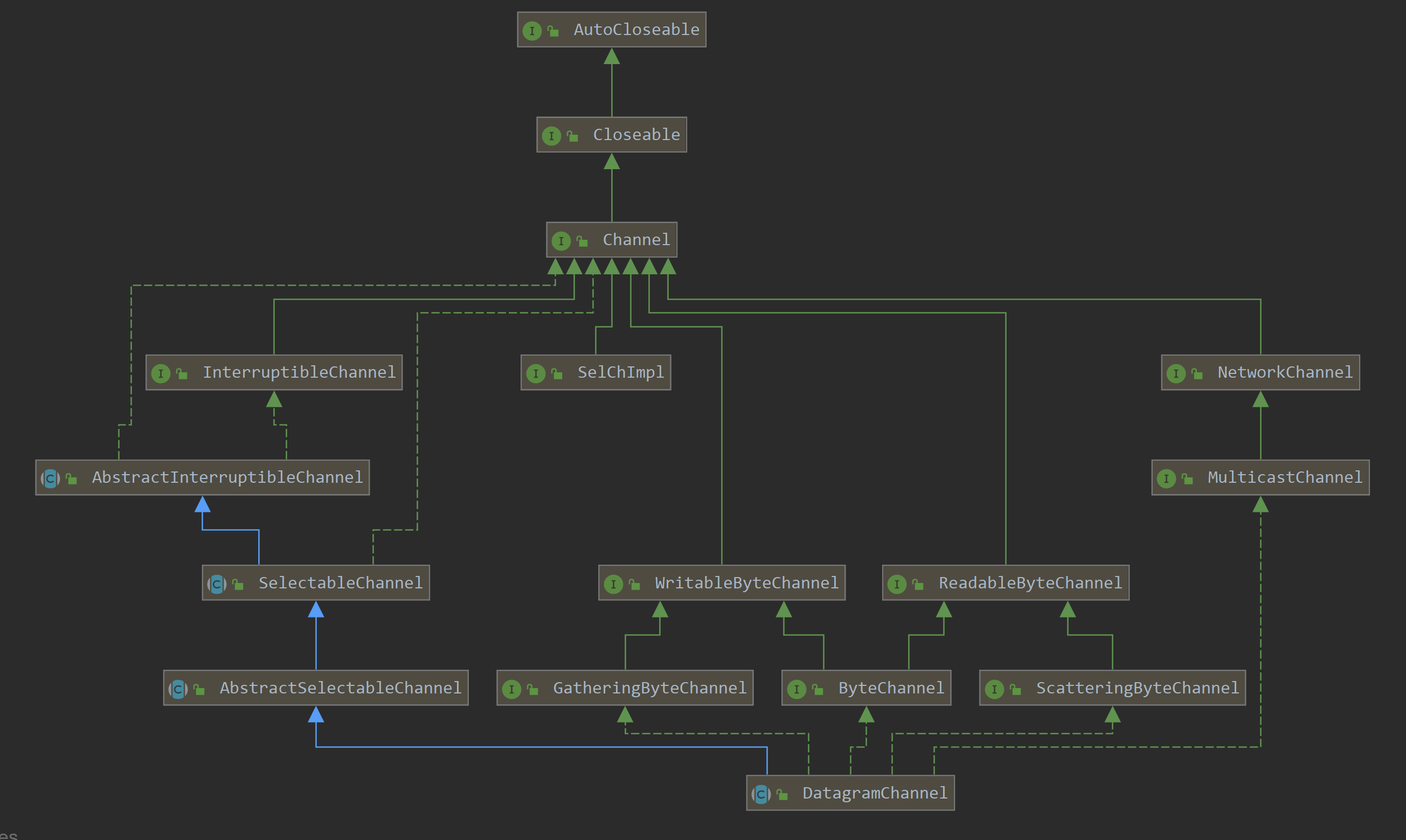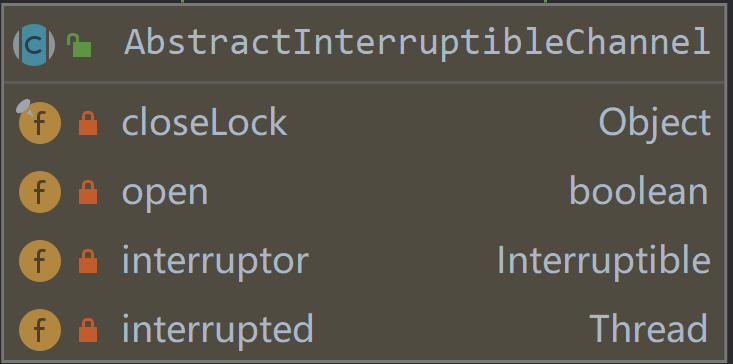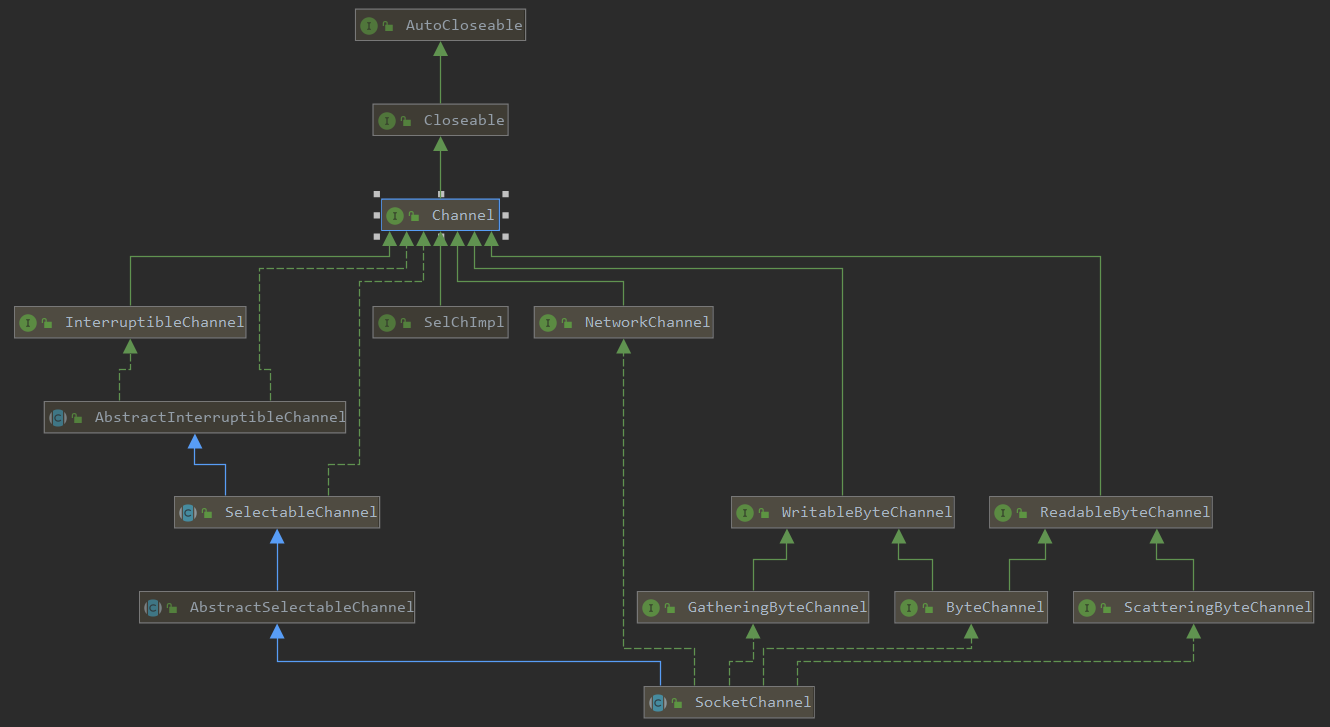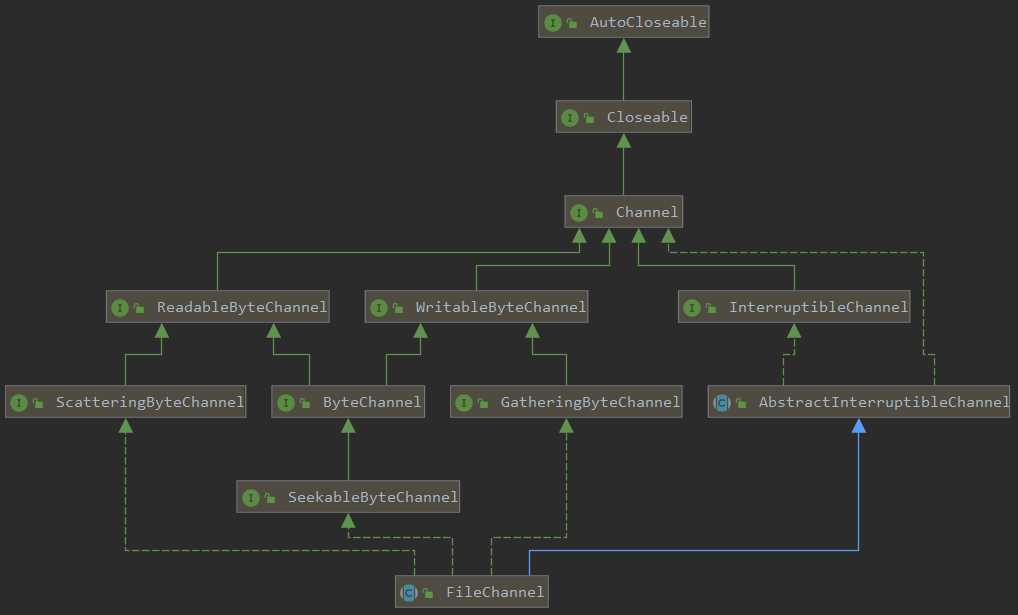NIO-Channel介面分析
目錄
- NIO-Channel原始碼分析
- 目錄
- 前言
- 介面
- SCTP協議
- UDP協議
- TCP協議
- 檔案
- 總結
- 相關文獻
NIO-Channel原始碼分析
目錄
NIO-概覽
NIO-Buffer
NIO-Channel
NIO-Channel原始碼分析
前言
本來是想學習Netty的,但是Netty是一個NIO框架,因此在學習netty之前,還是先梳理一下NIO的知識。通過剖析原始碼理解NIO的設計原理。
本系列文章針對的是JDK1.8.0.161的原始碼。
上一篇介紹了Channel的基本使用,下面對Channel的介面進行分析。
介面
SCTP協議
SCTP(Stream Control Transmission Protocol)是一種傳輸協議,在TCP/IP協議棧中所處的位置和TCP、UDP類似,兼有TCP/UDP兩者特徵。
對於SCTP協議這裡不詳細描述,想了解的同學可以看下這篇文章
SCTP協議平時用的不多,這裡不做具體討論。
UDP協議
NIO使用DatagrmChannel實現了UDP協議的網路通訊。

下面我們對各個介面進行分析。
AutoCloseable和Closeable
public interface AutoCloseable {
void close() throws Exception;
}
public interface Closeable extends AutoCloseable {
void close() throws IOException;
}Channel是通道介面,針對於I/O相關的操作,需要開啟和關閉操作。
public interface Channel extends Closeable { boolean isOpen(); void close() throws IOException; }
InterruptibleChannel是支援非同步關閉和中斷的通道介面。為了支援Thead的interrupt模型,當執行緒中斷時,可以執行中斷處理物件的回撥,從而關閉釋放Channel。
public interface InterruptibleChannel extends Channel {
void close() throws IOException;
}關於InterruptibleChannel可中斷I/O詳細解析可以看一下《JDK原始碼閱讀-InterruptibleChannel與可中斷IO》
Interruptible是執行緒中斷介面,即上面提的Thead的interrupt模型。當執行緒中斷時,則會呼叫中斷操作。
public abstract interface Interruptible {
public abstract void interrupt(java.lang.Thread t);
}
public class Thread implements Runnable {
...
public void interrupt() {
if (this != Thread.currentThread())
checkAccess();
synchronized (blockerLock) {
Interruptible b = blocker;
if (b != null) {
interrupt0(); // Just to set the interrupt flag
b.interrupt(this);
return;
}
}
interrupt0();
}
...
}AbstractInterruptibleChannel實現了Channel和InterruptibleChannel介面。

closeLock是關閉時的鎖open表示channle是否開啟interuptor為Interruptible中斷回撥interrupted為I/O執行時的執行緒
public abstract class AbstractInterruptibleChannel implements Channel, InterruptibleChannel {
...
public final void close() throws IOException {
synchronized(this.closeLock) {
if (this.open) {
this.open = false;
this.implCloseChannel();
}
}
}
//具體的Channel實現關閉
protected abstract void implCloseChannel() throws IOException;
protected final void begin() {
if (this.interruptor == null) {
this.interruptor = new Interruptible() {
//執行緒中斷時,則會呼叫該介面關閉Channel
public void interrupt(Thread target) {
synchronized(AbstractInterruptibleChannel.this.closeLock) {
if (AbstractInterruptibleChannel.this.open) {
AbstractInterruptibleChannel.this.open = false;
AbstractInterruptibleChannel.this.interrupted = target;
try {
AbstractInterruptibleChannel.this.implCloseChannel();
} catch (IOException x) {
}
}
}
}
};
}
//將執行緒的blockOn設定為當前interruptor,從而使得執行緒關閉時能關閉channel
blockedOn(this.interruptor);
Thread me = Thread.currentThread();
if (me.isInterrupted()) {
this.interruptor.interrupt(me);
}
}
protected final void end(boolean completed)
throws AsynchronousCloseException
{
//I/O結束,清除執行緒blocker
blockedOn(null);
Thread interrupted = this.interrupted;
if (interrupted != null && interrupted == Thread.currentThread()) {
interrupted = null;
throw new ClosedByInterruptException();
}
if (!completed && !open)
throw new AsynchronousCloseException();
}
static void blockedOn(Interruptible intr) {
SharedSecrets.getJavaLangAccess().blockedOn(Thread.currentThread(), intr);
}
}
AbstractInterruptibleChannel添加了begin和end方法。 在I/O操作開始時會呼叫begin,在I/O操作結束時會呼叫end。在begin方法內將中斷操作加入到當前執行緒中。最終會呼叫到執行緒的blockOn方法,它會將該中斷介面注入到執行緒中,使得執行緒中斷時可以呼叫到Channel並釋放相關資源。
public void blockedOn(Thread t, Interruptible b) {
t.blockedOn(b);
}SelectableChannel介面聲明瞭Channel是可以被選擇的,在Windows平臺通過WindowsSelectorImpl實現,Linux通過EPollSelectorImpl實現。此外還有KQueue等實現,關於Selector具體細節在《NIO-Selector》一文中會介紹。
AbstractSelectableChannel實現了SelectableChannel介面。
NetworkChannel適用於網路傳輸的介面。
public interface NetworkChannel extends Channel {
//繫結地址
NetworkChannel bind(SocketAddress var1) throws IOException;
//獲取本地地址
SocketAddress getLocalAddress() throws IOException;
//設定socket選項
<T> NetworkChannel setOption(SocketOption<T> var1, T var2) throws IOException;
//獲取socket選項
<T> T getOption(SocketOption<T> var1) throws IOException;
//當前通道支援的socket選項
Set<SocketOption<?>> supportedOptions();
}
MulticastChannel是支援組播介面。
public interface MulticastChannel extends NetworkChannel {
void close() throws IOException;
MembershipKey join(InetAddress group, NetworkInterface interf) throws IOException;
MembershipKey join(InetAddress group, NetworkInterface interf, InetAddress source) throws IOException;
}SelChImpl介面用於將底層的I/O就緒狀態更新為就緒事件。
public interface SelChImpl extends Channel {
FileDescriptor getFD();
int getFDVal();
//更新就緒事件
public boolean translateAndUpdateReadyOps(int ops, SelectionKeyImpl sk);
//設定就緒事件
public boolean translateAndSetReadyOps(int ops, SelectionKeyImpl sk);
//將底層的輪詢操作轉換為事件
void translateAndSetInterestOps(int ops, SelectionKeyImpl sk);
//返回channle支援的操作,比如讀操作、寫操作等
int validOps();
void kill() throws IOException;
}由於UDP支援讀寫資料,因此還實現了ReadableByteChannel和WritableByteChannel介面
public interface ReadableByteChannel extends Channel {
int read(ByteBuffer dst) throws IOException;
}
public interface WritableByteChannel extends Channel {
int write(ByteBuffer src) throws IOException;
}ByteChannel是支援讀寫的通道。
public interface ByteChannel extends ReadableByteChannel, WritableByteChannel {
}ScatteringByteChannel則支援根據傳入偏移量讀,支援根據傳入偏移量寫GatheringByteChannel
public interface ScatteringByteChannel extends ReadableByteChannel {
long read(ByteBuffer[] dsts, int offset, int length) throws IOException;
long read(ByteBuffer[] dsts) throws IOException;}
public interface GatheringByteChannel extends WritableByteChannel {
long write(ByteBuffer[] srcs, int offset, int length) throws IOException;
long write(ByteBuffer[] srcs) throws IOException;
}
TCP協議
客戶端

TCP協議除了不支援組播,其他和UDP是一樣的,不再重複介紹。
服務端

服務端無需資料讀寫,僅需要接收連線,資料讀寫是SocketChannel乾的事。因此沒有ReadableByteChannel、WriteableByteChannel等讀寫介面
檔案

檔案比網路協議少了NetworkChannel、SelChImpl和SelectableChannel。SelChImpl和SelectableChannel主要是用於支援選擇器的,由於網路傳輸大多數連線時空閒的,而且資料何時會到來並不知曉,同時需要支援高併發來連線,因此支援多路複用技術可以顯著的提高效能,而磁碟讀寫則沒有該需求,因此無需選擇器。
SeekableByteChannel可以通過修改position支援從指定位置讀寫資料。
public interface SeekableByteChannel extends ByteChannel {
int read(ByteBuffer dst) throws IOException;
int write(ByteBuffer src) throws IOException;
long position() throws IOException;
//設定偏移量
SeekableByteChannel position(long newPosition) throws IOException;
long size() throws IOException;
//擷取指定大小
SeekableByteChannel truncate(long size) throws IOException;
}總結
由於文章篇幅比較長,因此還是將介面分析和實現分析分開。本篇文章對Channel的介面進行說明,下一篇將對具體的實現進行分析。
相關文獻
- SCTP協議詳解
- 史上最強Java NIO入門:擔心從入門到放棄的,請讀這篇!
- Java NIO系列教程
- 為什麼SCTP沒有被大量使用/知道
- JDK原始碼閱讀-InterruptibleChannel與可中斷IO
- 廣播和組播
- 關於AccessController.doPrivileged
- ServiceLoader原始碼分析
- 基於Java的RDMA高效能通訊庫(六):SDP - Java Socket Direct Protocol

微信掃一掃二維碼關注訂閱號傑哥技術分享
出處:https://www.cnblogs.com/Jack-Blog/p/12040082.html
作者:傑哥很忙
本文使用「CC BY 4.0」創作共享協議。歡迎轉載,請在明顯位置給出出處及連結。
